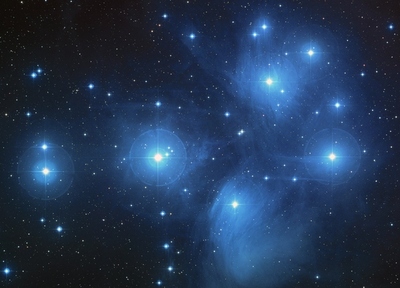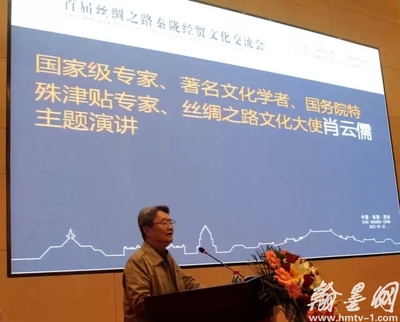星
文/阿瑟·克拉克
译/明子
这里距离梵蒂冈有三千光年。曾经,我相信空间没有力量支配信仰,如同我相信天堂宣扬上帝造物的荣耀。但如今我观察这些造物,我的信仰却遭受了深重的挫折。我凝视着挂在太空舱里六型计算机上的十字架,生命中第一次,我想知道这个符号是否只是个毫无意义的符号。
我未对任何人说过,但真相无法被掩埋。我们带回地球的数不尽的磁带和成千上万的照片记录了我们的探测数据,每个人都能读到。其他的科学家也能和我一样轻易地读取这些数据,我并不是一个能容忍篡改真相的人,历史上,这样的行径曾令我们修会声名狼藉。
船员们都很沮丧,我不知他们会怎样面对这终极讽刺。他们中少有人有宗教信仰,但他们并不打算以最终探测结果作为打败我的武器。——从离开地球开始,他们便在与我打着一场私下的、友善的,但十分严肃的战争。对他们而言,拥有一位出身于耶稣会的首席天体物理学家是十分滑稽的,钱德勒医生便是无法接受这一点的人之一(为何医学界人士都是这样的死理性派?)。有时我会在瞭望舱里遇见他,那里的光线总是很暗,窗外的星光未被削弱。他会在黑暗中走到我身边停下,透过巨大的椭圆形瞭望窗向外望,宇宙空间在我们周围随着飞船的自转而缓缓旋转,我们从不费心去停止飞船的这种旋转。
“那么,神父,”他最后说,“宇宙运行不止,也许是有某种‘东西’创造了它。但你如何相信这种‘东西’对我们和我们微不足道的世界给予了特殊优待?——这个问题让我很困惑。”接下来争论便会在我们之间展开,而星群和星云仍在我们周围静静旋转,在明净的塑料瞭望窗外划着无尽的弧线。
我想,我看起来矛盾的双重身份让船员们感到滑稽,即便我拿出我发表在《天体物理期刊》上的三篇论文和《皇家天文学会月刊》上的五篇论文也无济于事。我应该提醒他们,耶稣会长期以来都以其科学工作而著称于世。尽管我们现在人数很少,但从做出贡献的人数比例来看,我们自18世纪以来在天文学和地球物理学上都贡献卓著。不过,我那份关于凤凰星云的报告将会终结我们修会数千年的历史吗?我想是的,而且将会终结的不止这些。
我不知是谁给这星云命的名,在我看来这个命名很糟糕。如果这个名字包含一个预言,它需要数十亿年后才可能得到证实。甚至连“星云”这个词也会产生误导:与那些散布在漫长银河,正在不断形成的巨大云雾状星群相比,它只是一个极其微小的物质。事实上,以宇宙的尺寸而言,凤凰星云微不足道,它只是一层稀薄大气层包围着的一颗小小的恒星。
甚至,它只是一颗恒星的残骸……
光谱仪图谱上方挂着鲁本斯雕刻的罗耀拉像,他看起来像是在嘲笑我。神父啊,如果是你,将如何面对我现有的知识呢?那颗小小的地球对你而言就是整个宇宙,但我如今却已到达距离地球如此遥远的地方。我的信仰遭受挫折,如果是你,你会在此处奋起反抗吗?
神父啊,你凝视远方,但相比你一千年前创立耶稣会那时,我如今旅行的距离已远远超出你的想象。从来没有探测船飞离地球这么远,我们已经到达已知宇宙的边缘。我们出发飞往凤凰星云,我们抵达了,如今我们带着探测到的大量信息返航。我期盼有一天能够不再背负这些信息,但如今我却只能在远隔数个世纪、数万光年之外的地方呼唤你。
你手中的书,上面的字迹清晰可见:“愈显主荣”,这句话仍在流传,但我已不再相信。如果你能看见我们今天所看见的,你还能相信吗?
当然,我们知道凤凰星云是什么。仅仅是在银河系,每年就有上百颗恒星爆发,它们的亮度会在短短几个小时或几天之内增大数千倍,爆发过后,它们就会隐于黑暗,归于死亡。这些爆发的星通常都是“新星”——这些都是常见的宇宙灾难。自从我在月球观测台工作以来,我曾经记录过数十颗新星爆发的光谱和光变曲线。
不仅如此,每一千年都会出现三到四次重大天文现象,让新星爆发更加不足为奇。
当一颗恒星演变成一颗超新星时,它的亮度会在一瞬间超过银河系所有恒星的总和。中国的天文学家曾在公元1054年目睹了这一现象,但他们当时并不理解。五个世纪后的1572年,一颗超新星在仙后座爆发,亮度之大,即便在白天也能看见。在之后的一千年里,还曾出现过三颗超新星。
我们的任务就是探访此类灾难的残骸现场,并还原事故诱因,如果可能的话,还要弄清事故发生的根本原因。我们缓缓穿过这颗六千年前爆发的恒星的大气层,大气层目前仍在膨胀。它的温度很高,散发着强烈的紫色光芒,只是大气层很稀薄,尚不足以伤害我们。当年这颗恒星爆发时,它的外层被以极大的速率向外抛离,彻底脱离了恒星引力场。如今那些外层形成了一个巨大的空壳,它的内部大得足以容纳一千个太阳系,而它的中心是仍在燃烧的、微小的、奇妙的物质——白矮星,最终这整个恒星都会变成白矮星。白矮星的体积比地球还要小,但重量却是地球的数百万倍。
发光的大气层包围着我们,驱散了通常宇宙星际间的黑暗。我们向恒星中心飞去,这是一颗数千年前爆炸的宇宙炸弹,爆炸产生的炽热碎片如今仍在向外迅速扩散。爆炸规模如此之大,以致其产生的碎片大量分布在周围数亿英里范围内,密集如凝固的整体。或许要若干年后,肉眼才能看清那些微弱运动的气流和大气漩涡,但如今膨胀的星云也使人很震撼了。
我们在几个小时前关闭了飞船的主动力,以余速向那颗暴烈的星球缓缓滑去。这颗星球曾经也和我们的太阳一样,但它在短短数小时内消耗了原本可以使它燃烧数百万年的能量。如今它就像一个节俭的吝啬鬼,精打细算着余留的能量,仿佛要去弥补年轻时挥霍掉的每一分财富。
没人认为在这种情况下能发现行星,即便曾经有,它们也会在那次大爆发中化为青烟,它们的组成物质也会消散在那颗恒星的残骸中,无法分辨。但是,当我们打开自动搜索引擎时——我们在接近一颗不知名的恒星时总这样做——我们很快发现了一颗很小的行星,它在很远的距离之外环绕着这颗恒星运行,正如寂静太阳系里的冥王星,在黑夜的边缘运行。它距离中央的恒星非常遥远,以至于生命无法生存,但也使得它免于像其他行星那样灭亡的命运。
那场大火烧焦了这颗行星上的岩石,也烧尽了灾难发生前覆盖在地表的固态气体。我们在这颗行星上着陆了,接着,我们发现了一座纪念营。
纪念营的建造者们尽一切努力使后来者能够发现它。门口巨大的标志如今只剩下一个熔化的残骸,但即便是通过第一批远程照片,我们也能知道这里是智慧劳动的产物。稍后,我们又检测到埋在岩石之下的陆地辐射纹。即便纪念营上方的指示塔毁灭了,陆地辐射纹也不会消失,这是一个呼唤群星的永恒信号,我们的飞船正是被这信号引导而来。
这个指示塔建塔之初约有一英里高,但它现在矮如一只融化在蜡液里的蜡烛。我们花了一周的时间才打穿这些融化的岩石,毕竟我们手头没有更好的工具。我们只是天文学家,而不是考古学家,但我们尽力而为。其他的那些因素都不重要,因为我们明白:他们在尽可能远离那颗恒星的此处,费尽心力建造这座孤独的纪念碑,只会有一个目的。一个文明,自知即将毁灭,它要给无尽的未来留下最后的印记。
我们需要几代人才能完全弄明白这个纪念营留下的财富。他们的太阳在爆发之前的很多年,就给予了他们第一次预警,使得他们有充足的时间来筹建这个纪念营。每一样他们的珍藏之物,每一个他们的智慧之果,他们都在末日降临之前带来此处,希望有朝一日能被其他生命发现,使他们不被永久遗忘。如果换做是我们,面对同样的命运,我们也会这样做吗?或者,我们会由于看不见也摸不着未来而在困苦中迷失自我?
如果留给他们的时间再多一点就好了!他们已经能够在所在星系的行星之间自由穿行,但他们还不具备跨越星系的能力,最近的星系距离他们也有一百万光年。即便他们掌握了超动力飞行技术,也不过能救几百万人。或许现在这样的结局更好。
尽管他们留下的雕塑显示出他们十分不安,我们仍然会忍不住赞叹他们,但也会为他们的命运哀悼。他们留下了大量影像资料,甚至还有许多放映机器,连同那些精心描绘的符号,使我们不难学会他们的书面语言。我们查看了他们留下的许多记录,那个文明的活力与美丽在六千年后第一次得以展现,那个文明在许多方面甚至比我们更优越。尽管他们可能只展示了最好的一面,但谁又能责备他们呢?他们的世界十分美好,他们的城市很优雅,各方面都适合居住。我们看他们工作、娱乐,聆听他们使用了数个世纪的音乐般的语言。有一个场景总是在我眼前闪现:一群孩子在奇特的蓝色沙滩上,如同地球的孩子一样在浪花里玩耍。古怪如鞭子一样的树沿海岸生长,一些巨大的动物在浅滩里游走,但没人担心它们。
而那缓缓沉入大海、依旧温暖、友好、赋予生命的太阳,却将背叛这一切,它将毁灭所有这些无辜的快乐。
或许是因为我们离家太远,或许是因为我们太过孤单、因而脆弱,但我们从未如此触动。我们中的许多人曾在其他星球见过古老文明的残骸,但没有一次这么震撼,这次的悲剧是这样特殊。在地球上,国家和文明的衰落与毁灭司空见惯,但在这里,一颗文明如此璀璨的星球却这样迅速地被毁灭,未留下任何幸存者,这让人如何理解上帝的仁慈?
同事们也问过我这个问题,我只能勉为其难地回答。如果是你,罗耀拉神父,或许会回答得更好一些,但我并未从你的《神操》中获得任何帮助。他们并非恶人,我并不知道他们礼拜什么神,如果他们也礼拜神的话。但我穿越数个世纪的时光回望他们,看他们用他们最后的力气保存那些美好之物,如今,那些美好之物得以在这颗萎缩恒星的光芒下重新展现。我们本可以从中学到更多,但他们为什么会被毁灭呢?
对于这个问题,我知道回到地球后我的同事们将如何作答,他们会说:宇宙运行本无目的、本无计划,既然银河系每年都有上百颗恒星爆发,那么此刻在宇宙深处,必定也有一个文明正在灭亡。不论这个文明是善还是恶,结局都一样,并没有末日审判,因为本没有神。
然而,我们目前所见却不能证明这种看法。有这样看法的人不过是感性行事,并无逻辑。上帝无需向人类解释他的神迹,他创造宇宙,他也可以随时毁灭。我们评判他的任何作为或不作为,都是一种自大,甚至是一种亵渎。
我本可以硬着心肠接受这一切,看着整个星球和星球上的所有居民毁于大火。但是,如果某一点被揭示,我最后的信仰也将颤抖。现在,我看到了这个运算结果,我知道这一点终究摆在了我的面前。
当我们到达凤凰星云之前,我们不知道那场爆发在何时发生。如今,通过天文迹象和那颗残存行星的岩石记录,我们能够精确推算出爆发时间,还能知道这场大爆发产生的火光在哪一年抵达地球。现在,我们的飞船飞速离开凤凰星云,而我知道我们身后的那颗只剩残骸的超新星当年曾怎样闪耀于地球的上空。我知道它曾经怎样在日出之前熊熊燃烧于天边,如同一座灯塔,在黎明的东方引领光明的到来。
勿需怀疑了,古老的秘密终被揭开。但是,上帝啊,世间有千千万万颗星球可供驱使,为什么你偏偏选择这一颗,为什么你将所有的人送给大火,只为让这颗象征他们往昔生命的星球照亮伯利恒、照亮耶稣诞生的黎明?
————————————
附英语原文:
TheStar
by Arthur C. Clarke
It is three thousandlight-years to the Vatican. Once, I believed that space could haveno power over faith, just as I believed that the heavens declaredthe glory of God's handiwork. Now I have seen that handiwork, andmy faith is sorely troubled.Istare at the crucifix that hangs on the cabin above the Mark VIComputer, and for the first time in my life I wonder if it is nomore than an empty symbol.
I have told no one yet,but the truth cannot be concealed. The facts are there for all toread, recorded on the countless miles of magnetic tape andthousands of photographs we are carrying back to Earth. Otherscientists can interpret them as easily as I can, and I am not onewho would condone that tampering with the truth which often gave myorder a bad name in the olden days.
The crew are alreadysufficiently depressed: I wonder how they will take this ultimateirony. Few them have any religious faith, yet they will not relishusing this final weapon in their campaign against me—that private,good‑natured, but fundamentally serious, war which lasted all theway from Earth. It amused them to have a Jesuit as chiefastrophysicist: Dr. Chandler, for instance, could never get over it(why are medical men such notorious atheists?). Sometimes he wouldmeet me on the observation deck, where the lights are always so lowthat the stars shine with undiminished glory. He would come up tome in the gloom and stand staring out of the great oval port, whilethe heavens crawled slowly around us as the ship turned end overend with the residual spin we had never bothered to correct.
"Well, Father," he wouldsay at last, "it goes on forever and forever, andperhapsSomethingmade it.But how you can believethatSomethinghas aspecial interest in us and our miserable little world—that justbeats me." Then the argument would start, while the stars andnebulae would swing around us in silent, endless arcs beyond theflawlessly clear plastic of the observation port.
It was, I think, theapparent incongruity of position that caused most amusement to thecrew. In vain I would point to my three papers intheAstrophysical Journal, my five intheMonthly Notices of the Royal AstronomicalSociety. I would remind them that my order has long been famousfor its scientific works. We may be few now, ever since theeighteenth century we have made contributions to astronomy andgeophysics out of all proportion to our numbers. Will my report onthe Phoenix Nebula end our thousand years of history? It will end,I fear, much more than that.
I do not know who gave thenebula its name, which seems to me a very bad one. If it contains aprophecy, it is one that cannot be verified for several billionyears. Even the word nebula is misleading: this is a far smallerobject than those stupendous clouds of mist—the stuff of unbornstars-that are scattered throughout the length of the Milky Way. Onthe cosmic scale, indeed, the Phoenix Nebula is a tiny thing—atenuous shell of gas surrounding a single star.
Or what is left of astar...
The Rubens engraving ofLoyola seems to mock me as it hangs there above thespectrophotometer tracings. What wouldyou,Father, have made of knowledge that has come into my keeping, sofar from the little world that was all the universe you knew? Wouldyour faith have risen to the challenge, as mine has failed todo?
You gaze into thedistance, Father, but I have traveled a distance beyond any thatyou could have imagined when you founded our order a thousand yearsago. No other survey ship has been so from Earth: we are at thevery frontiers of the explored universe. We set out to reach thePhoenix Nebula, we succeeded, and we are homeward bound with ourburden of knowledge. I wish I could lift that burden from myshoulders, but I call to you in vain across the centuries and thelight‑years that lie between us.
On the book you areholding the words are plain to read. AD MAIOREM DEI GLORIAM, themessage runs, but it is a message I can no longer believe. Wouldyou still believe it, if you could see what we have found?
We knew, of course, whatthe Phoenix Nebula was. Every year, in our galaxy alone, more thana hundred stars explode, blazing for a few hours or days withthousands of times their normal brilliance before they sink backinto death and obscurity. Such are the ordinary novae—thecommonplace disasters of the universe. I have recorded thespectrograms and light curves of dozens since I started working atthe Lunar Observatory.
But three or four times inevery thousand years occurs something beside which even a novapales into total insignificance.
When a star becomesasupernova, it may for a little whileoutshine all the massed suns of the galaxy. The Chinese astronomerswatched this happen in A.D. 1054, not knowing what it was they saw.Five centuries later, in 1572, a supernova blazed in Cassiopeia sobrilliantly that it was visible in the daylight sky. There havebeen three more in the thousand years that have passed sincethen.
Our mission was to visitthe remnants of such a catastrophe, to reconstruct the events thatled up to it, and, if possible, to learn its cause. We came slowlyin through the concentric shells of gas that had been blasted outsix thousand years before, yet were expanding still. They wereimmensely hot, radiating even now with a fierce violet light, butwere far too tenuous to do us any damage. When the star hadexploded, its outer layers had been driven upward with such speedthat they had escaped completely from its gravitational field. Nowthey formed a hollow shell large enough to engulf a thousand solarsystems, and at its center burned the tiny, fantastic object whichthe star had now become—a White Dwarf, smaller than the Earth, yetweighing a million times as much.
The glowing gas shellswere all around us, banishing the normal night of interstellarspace. We were flying into the center of a cosmic bomb that haddetonated millennia ago and whose incandescent fragments were stillhurtling apart. The immense scale of the explosion, and the factthat the debris already covered a volume of space many billions ofmiles across, robbed the scene of any visible movement. It wouldtake decades before the unaided eye could detect any motion inthese tortured wisps and eddies of gas, yet the sense of turbulentexpansion was overwhelming.
We had checked our primarydrive hours before, and were drifting slowly toward the fiercelittle star ahead. Once it had been a sun like our own, but it hadsquandered in a few hours the energy that should have kept itshining for a million years. Now it was a shrunken miser, hoardingits resources as if trying to make amends for its prodigalyouth.
No one seriously expectedto find planets. If there had been any before the explosion, theywould have been boiled into puffs of vapor, and their substancelost in the greater wreckage of the star itself. But we made theautomatic search, as we always do when approaching an unknown sun,and presently we found a single small world circling the star at animmense distance. It must have been the Pluto of this vanishedsolar system, orbiting on the frontiers of the night. Too far fromthe central sun ever to have known life, its remoteness had savedit from the fate of all its lost companions.
The passing fires hadseared its rocks and burned away the mantle of frozen gas that musthave covered it in the days before the disaster. We landed, and wefound the Vault.
Its builders had made surethat we should. The monolithic marker that stood above the entrancewas now a fused stump, but even the first long‑range photographstold us that here was the work of intelligence. A little later wedetected the continent-wide pattern of radioactivity that had beenburied in the rock. Even if the pylon above the Vault had beendestroyed, this would have remained, an immovable and all buteternal beacon calling to the stars. Our ship fell toward thisgigantic bull's‑eye like an arrow into its target.
The pylon must have been amile high when it was built, but now it looked like a candle thathad melted down into a puddle of wax. It took us a week to drillthrough the fused rock, since we did not have the proper tools fora task like this. We were astronomers, not archaeologists, but wecould improvise. Our original purpose was forgotten: this lonelymonument, reared with such labor at the greatest possible distancefrom the doomed sun, could have only one meaning. A civilizationthat knew it was about to die had made its last bid forimmortality.

It will take usgenerations to examine all the treasures that were placed in theVault. They had plenty of time to prepare, for their sun must havegiven its first warnings many years before the final detonation.Everything that they wished to preserve, all the fruit of theirgenius, they brought here to this distant world in the days beforethe end, hoping that some other race would find it and that theywould not be utterly forgotten. Would we have done as well, orwould we have been too lost in our own misery to give thought to afuture we could never see or share?
If only they had had alittle more time! They could travel freely enough between theplanets of their own sun, but they had not yet learned to cross theinterstellar gulfs, and the nearest solar system was a hundredlight‑years away. Yet even had they possessed the secret of theTransfinite Drive, no more than a few millions could have beensaved. Perhaps it was better thus.
Even if they had not beenso disturbingly human as their sculpture shows, we could not havehelped admiring them and grieving for theirfate.They left thousands ofvisual records and the machines for projecting them, together withelaborate pictorial instructions from which it will not bedifficult to learn their written language. We have examined many ofthese records, and brought to life for the first time in sixthousand years the warmth and beauty of a civilization that in manyways must have been superior to our own. Perhaps they only showedus the best, and one can hardly blame them. But their worlds werevery lovely, and their cities were built with a grace that matchesanything of man's. We have watched them at work and play, andlistened to their musical speech sounding across the centuries. Onescene is still before my eyes—a group of children on a beach ofstrange blue sand, playing in the waves as children play on Earth.Curious whip-like trees line the shore, and some very large animalis wading in the shallows yet attracting no attention at all.
And sinking into the sea,still warm and friendly and life‑giving, is the sun that will soonturn traitor and obliterate all this innocent happiness.
Perhaps if we had not beenso far from home and so vulnerable to loneliness, we should nothave been so deeply moved. Many of us had seen the ruins of ancientcivilizations on other worlds, but they had never affected us soprofoundly. This tragedy was unique. It is one thing for a race tofail and die, as nations and cultures have done on Earth. But to bedestroyed so completely in the full flower of its achievement,leaving no survivors—how could that be reconciled with the mercy ofGod?
My colleagues have askedme that, and I have given what answers I can. Perhaps you couldhave done better, Father Loyola, but I have found nothing intheExercitiaSpiritualiathat helps me here. They were notan evil people: I do not know what gods they worshiped, if indeedthey worshiped any. But I have looked back at them across thecenturies and have watched while the loveliness they used theirlast strength to preserve was brought forth again into the light oftheir shrunken sun. They could have taught us much: why were theydestroyed?
I know the answers that mycolleagues will give when they get back to Earth. They will saythat the universe has no purpose and no plan, that since a hundredsuns explode every year in our galaxy, at this very moment somerace is dying in the depths of space. Whether that race has donegood or evil during its lifetime will make no difference in theend: there is no divine justice, for there is no God.
Yet, of course, what wehave seen proves nothing of the sort. Anyone who argues thus isbeing swayed by emotion, not logic. God has no need to justify Hisactions to man. He who built the universe can destroy it when Hechooses. It is arrogance—it is perilously near blasphemy—for us tosay what He may or may not do.
This I could haveaccepted, hard though it is to look upon whole worlds and peoplesthrown into the furnace. But there comes a point when even thedeepest faith must falter, and now, as I look at the calculationslying before me, I know I have reached that point at last.
We could not tell, beforewe reached the nebula, how long ago the explosion took place. Now,from the astronomical evidence and the record in the rocks of thatone surviving planet, I have been able to date it very exactly. Iknow in what year the light of this colossal conflagration reachedour Earth.I know howbrilliantly the supernova whose corpse now dwindles behind ourspeeding ship once shone in terrestrial skies. I know how it musthave blazed low in the east before sunrise, like a beacon in thatoriental dawn.
There can be no reasonabledoubt: the ancient mystery is solved at last. Yet, oh God, therewere so many stars you could have used. What was the need to givethese people to the fire, that the symbol of their passing mightshine above Bethlehem?
 爱华网
爱华网



